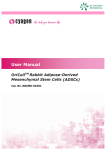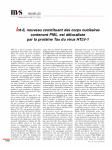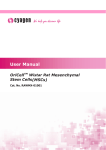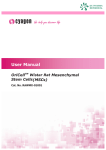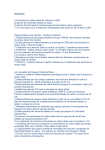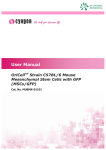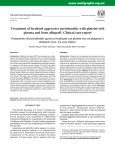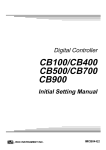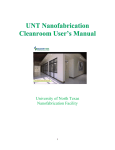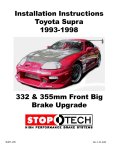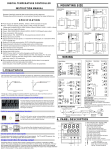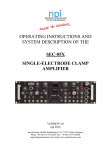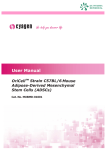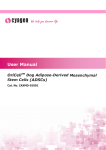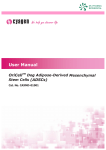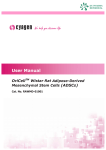Download Rabbit Adipose-Derived Mesenchymal Stem Cells
Transcript
User Manual OriCellTM Rabbit Adipose-Derived Mesenchymal Stem Cells (ADSCs) Cat. No. RBXMD-01001 Table of Contents Contents and Storage ………………………………………………………………………………………3 Product Introduction…………………………………………………………………………………………3 Cell Characteristics and Identity …………………………………………………………………………3 Product Applications ………………………………………………………………………………………4 General Handling Principles ………………………………………………………………………………4 Culturing OriCellTM Rabbit ADSCs Thawing and Establishing OriCellTM Rabbit ADSCs …………………………………………………4 Passaging Cyagen OriCellTM Rabbit ADSCs ………………………………….……………………… 6 Differentiation of OriCellTM Rabbit ADSCs ……………………………………………………………8 Cryopreservation of OriCellTM Rabbit ADSCs ………………..………………………………………12 Appendix … ……………… ……………………………………………………………14 Troubleshooting ……………………………………………………………………………………………14 Related Products …………………………………………………………………………………………15 References ……………………………………………………………………………………………………15 CONTENTS AND STORAGE Product Name Rabbit Adipose‐Derived Mesenchymal Stem Cells Catalog No. RBXMD‐01001 Amount per Vial 1×106 Cells Cryopreserved At Second Passage Storage Condition Liquid Nitrogen CAUTION: Please handle this product as a potentially biohazardous material. This product contains Dimethyl Sulfoxide (DMSO), a hazardous material, in the freezing medium. PRODUCT INTRODUCTION Adipose-Derived Mesenchymal Stem Cells (ADSCs) are multipotent stem cells that can differentiate into a variety of cell types, including osteocytes, adipocytes and chondrocytes. They have wide application potentials in tissue engineering, cell therapy and gene therapy. OriCellTM Rabbit Adipose-derived Mesenchymal Stem Cells (ADSCs) are derived from adipose tissue of healthy Rabbit by liposuction. They have a strong capacity for selfrenewal while maintaining multipotency. In addition, these cells have been tested for: • Exogenous Factors: bacterial/fungal contamination, mycoplasma contamination, and endotoxin contamination. • Characteristics: post-thaw viability, cell cycle, verification of undifferentiated state, and differentiation potential. This product is intended for laboratory research use only. It is not intended for diagnostic, therapeutic, clinical, household, or any other applications. CELL CHARACTERISTICS AND IDENTITY • Strong capacity to expand. Can be passaged at least 5 times. • Multipotent differentiation ability along the osteogenic, chondrogenic, and IMPI0022A2 RBXMD‐01001 Page 3 of 15 adipo ogenic linea ages. PRODUC CT APPL LICATIO ONS Adip pose-Derive ed Mesench hymal Stem m Cells (ADSCs) have become a popular res search targ get due to their t potenttial use in rregenerativ ve medicine e and tissue e engineering (in area as such as cardiovascular, neura l and ortho opaedic dise ease). CellTM Rabbit Adipose-Derived Me esenchymal Stem Cells can be ussed as cell models to OriC testt and evaluate the imm munoreacti ons, prolife eration, imm migration a and differen ntiation of ADS SCs both in vivo and in n vitro. GENERA AL HAND DLING PRINCIP P PLES 1.. Aseptic handling h of the producct is necess sary through hout. 2.. Once the e cells have been estab blished, alw ways freeze e up severa al vials of AdiposeDerived Mesenchym M mal Stem Ce ells (ADSCs s) as a backup. Note: The O OriCellTM RABBIT ADSC Cs can be fr rozen/thaw wed at leastt one times s. N nance of ce ells, we reco ommend th he seeding density to be 2.03.. For general mainten 2 c . 2.5×104cells/cm 4.. For all studies, it is strongly re ecommende ed to use ce ells that are e at, or und der, an p number of 10 0. original passage 5.. For general mainten nance of ce ells, we reco ommend th hat the med dium is cha anged if it e pH indicattor in culture medium appears ye ellow). In general, g becomes acidic (the very three days. d change the growth medium ev et Rabbit AD DSCs overg grow, as it will w result in contact in nhibition. When W the 6.. Do not le cells are 80-90% co onfluent, su ubculturing the cells is s strongly rrecommend ded. Note: We sttrongly reco ommend th he use of Or riCellTM cult ture media and other related N re eagents for optimal re esults. THAWIN T NG AND ESTABL LISHING G OriCelllTM RABBIT ADS SCs M Materials Required R OriCellTM Rabbit Adipose-Deriv ved Stem Cells (Cat. No. N RBXMD--01001) OriCellTM Adipose-De erived Stem m Cell Grow wth Medium m (Cat. No. GUXMD-90 0011) Th hawing and a Estab blishing R Rabbit ADSCs IMPI0022A2 RB BXMD‐01001 Page 4 of 15 1. Pre-warm m the fully supplemen s ted (complete) OriCelllTM ADSCs Growth Me edium to 37°C. 2. L of OriCellTM ADSC G rowth Mediium to a 15 5 mL conica al tube. Add 9 mL 3. Remove the cryovia al of OriCelllTM Rabbit ADSCs m liquid nitrrogen. from A 4. t the cryovial in a 37°C water bath until the last icce crystal disappears. Quickly thaw For optim mal results, be sure to o finish the thawing prrocedure wiithin 3 minutes. Be careful not to subm merge the en ntire vial. Maximum cell c viability y is depend dent on the d complete thawing off frozen cells. rapid and ess than op ptimal if the e cells are thawed t forr more than n 3 minutes s. N Note: Resultts will be le 5. As soon as a the cells s are complletely thawed, disinfec ct the outsiide of the cryovial c with 70% % v/v ethan nol. 6. TM Use a pip pette to transfer the ccells to the 15 mL coniical tube co ontaining OriCell O Rabbit AD DSC Growtth Medium inside a bio osafety cabinet. Be ca areful not to t introduce e any bubb bles during the transfe er process. 7. Rinse the e vial with 1 mL of the e medium to t reduce cell loss. Su ubsequently y transfer this 1 mL L of cell sus spension in nto the conical tube. 8. Gently mix m the cell suspension n by slowly pipetting up u and dow wn. Be care eful not to introduce e any bubbles. 9. Centrifug ge the cell suspension s at 250 x g for 5 minu utes. 0. Carefully y aspirate off as much of the supernatant as s possible a and add 2-3 3 mL of 10 fresh OriCellTM Rabb bit ADSC Grrowth Mediium (pre-warmed to 3 37°C). 11 1. Gently re esuspend th he cells in O OriCellTM Ra abbit ADSC C Growth Me edium. 12 2. Seed the e cells into a T25 flask k and add a sufficient amount a of OriCellTM Rabbit ADSC C Growth Medium. M Gently rock the culture e flask to ev venly distrib bute the ce ells. 13 3. Incubate e the flask at a 37°C ins ide a 5% CO C 2 humidiffied incubattor. 14 4. The nextt day, chang ge the med dium with fresh f growth medium (pre-warmed to 37°C C). 15 5. Change the t growth medium ev very two da ays until the cells are 80% confluent thereafte er. 16 6. When the e cells are approximattely 80-90% % confluent, they can n be dissociated with 0.25%Trrypsin-0.04%EDTA an d passaged d. IMPI0022A2 RB BXMD‐01001 Page 5 of 15 N Note: Chang ging Mediium 1.. Warm an n appropriatte amount of medium to 37°C in a sterile co ontainer. Replace R the e spent me edium with the pre-wa armed, fres sh medium.. Once com mpleted, retturn the flask to the t incubator. 2.. Avoid rep peated war rming and c cooling of the medium m. If the en ntire conten nt is not needed fo or a single procedure,, transfer only o the req quired volu me to a ste erile secondarry container. TM M F Fig. 1 OriCell Rabbit Adipo ose-Derived Mesenchymal M Stem S Cells are e established PASSAG GING OrriCellTM RABBIT T ADSCs M Materials Required R • 0.25%Tryp psin-0.04%EDTA (Cat. N No. TEDTA-10001) • Phosphatte-Buffered d Saline (1× ×PBS) (Cat. No. PBS-1 10001) • OriCellTM Rabbit Adipose-derive ed Stem Ce ells (Cat. No. RBXMD--01001) • OriCellTM Mesenchym mal Stem C Cell Growth Medium (C Cat. No. GU UXMX-9001 11) a for Rabbitt adipose-d erived mes senchymal stem cells ffrom other r companies N Note: Media s ca an be applie ed to the cu ulturing of OriCellTM Rabbit R Adipo ose-derived d Stem Cellls. 1.. Pre-warm m the OriCe ellTM MSC G rowth Medium, 1×PBS S, and 0.25 5%Trypsin-0.04%ED DTA solution n to 37°C. 2.. Carefully aspirate th he spent m edium from m the 80-90 0% conflue ent monolay yer of ADSCs. 3.. Add 1×PBS (6 mL fo or T75 flask k, 3 mL forr T25 flask). Be carefu ul not to disturb the er. Gently rock the fla ask back an nd forth to rinse the m monolayer. monolaye 4.. Aspirate 1×PBS off and discard d. 5.. Repeat stteps 3-4 tw wo or three times. 6.. Add 0.25 5%Trypsin-0.04%EDTA A solution (2-3 mL for T75 flask,, 1 mL for T25 T flask). Gently ro ock the flask back and d forth to en nsure that the entire m monolayer is covered with the 0.25%Tryp psin-0.04% %EDTA soluttion. Allow trypsinizatiion to continue until IMPI0022A2 RB BXMD‐01001 Page 6 of 15 oint, gently the majo ority of the cells (appro oximately 80%) 8 are rounded up.. At this po tap the side s of the flask f to rele ease the majority of cells from th he culture flask f surface. xposed to th he trypsin longer l than n necessary y (no mportant: Avoid leaviing cells ex Im mo ore than tw wo minutes if using Cy yagen’s tryp psin-EDTA solution). C Care should d also be e taken thatt the cells are a not forc ced to detach prematu urely as thiis may resu ult in clu umping. 7.. After the e cells are visibly v detacched, imme ediately add the pre-w warmed OriiCellTM MSC C Growth Medium M (6 mL for T75 5 flask, 3 mL m for T25 flask) to ne utralize the e trypsiniza ation. 8.. Gently piipette the medium m ove er the cells s to dislodge and resusspend the cells. c Repeat 5-6 5 times until all the ccells are dissociated from the fla ask and eve enly dispersed d into a single cell susspension. 9.. Transfer the dissociated cells i nto a 15 mL m conical tu ube. 10 0. Centrifug ge at 250 x g for 5 mi nutes. 11 1. Carefully y aspirate off as much of the supernatant as s possible. 12 2. Add 2 mL L of OriCellTM ADSC G rowth Mediium to the conical tub be and genttly resuspen nd the cells thoroughly y. 13 3. Plate the e cells into appropriate a e flasks. OriCellTM Rab bbit ADSCs can be split at 1:3 orr other app propriate ra atios. 14 4. Add an appropriate a amount off medium to o the cells. Incubate tthe cells at 37°C inside a 5% 5 CO2 hu umidified in ncubator. N Note: Care should be taken t to av void introdu ucing bubbles during pipetting. Ad dditional Tips Tiime to Cha ange Mediium It is recomm mended to change c the culture me edium if the ere are too o many dea ad cells affter passaging. It is recomm mended to change c the culture me edium whenever the m medium be ecomes ac cidic, even if the cells do not rea ach 80-90% % confluenc cy. The pH indicator in n the cu ulture mediium will appear yellow w when acid dic. In gene eral, chang ge the grow wth medium m ev very three days. d bculture Tiime to Sub W When OriCelllTM Rabbit ADSCs A are 80-90% confluent, c it is recomm mended that the cells s be e subculturred. Do not let the cellls overgrow w as it will result r in co ntact inhibition. IMPI0022A2 RB BXMD‐01001 Page 7 of 15 Pas ssage 3-40x Pa assage 3-100x x TM Fig. 2 Images of OriCell O Rabbitt Adipose-Derrived Mesenchymal Stem Ce ells at passage 3. C DIFFE RENTIA ATION USING U O OriCellTM OriCellTTM RABBIT ADSC DIFFER RENTIAT TION ME EDIA OriCellTM Rab bbit ADSCs can differe entiate into a variety of o cell typess including osteocytes s, dipocytes, and a chondrrocytes. ad O Osteogenic Differen ntiation Materials Required R M Osteogenic senchymal Stem Cell O c Differentia ation Mediu um (Cat. No o. GUXMXOriCellTM Mes 0021) 90 Osteogenes sis Protoco ol Note: The protocol listed below iss for 6-welll tissue cultture platess. N M Rabbit AD DSCs in OriCellTM Mese enchymal S Stem Cell Growth G 1.. Culture the OriCellTM a 37°C in a 5% CO2 humidified incubator. Medium at 3.. Reseed th he ADSCs in the grow wth medium m at 2×104 cells/cm2 iin a 6-well tissue culture plate pre-co oated with 0 0.1% gelatin solution. 4.. Incubate the cells at 37°C in a 5% CO2 humidified h incubator. 5.. When cells are apprroximately 60-70% co onfluent, carefully asp irate off the growth al Stem Ce dd 2 mL of OriCellTM Mesenchyma M ell medium from each well and ad nic Differentiation Med dium. Osteogen 6.. Feed cells s every 3 days for 2-3 3 weeks by completely y replacing the medium with fresh OriC CellTM Mese enchymal S Stem Cell Osteogenic O Differentiat D tion Medium m (prewarmed to t 37°C). 7.. After 2-3 weeks of differentiati d ion, cells ca an be fixed and staine ed with alizarin red S. IMPI0022A2 RB BXMD‐01001 Page 8 of 15 event osteoblasts from m detaching g, it is recommended tto change half h of the No ote: To pre me edium everry two days s before ana alysis. Allizarin Red d S Stainin ng Analysiis ve the osteo ogenic diffe erentiation medium 1.. After the cells have differentiatted, remov from the wells and rinse with 1 1x phospha ate-buffered d saline (PB BS). Fix ce ells with 2 mL of 4% % formaldeh hyde soluti on for 30 minutes. m 2.. Rinse wells twice with 1x PBS. Stain the cells with 1 mL alizarrin red S wo orking f for 3-5 min nutes. solution 3.. Rinse wells 2-3 time es with 1x P PBS. 4.. Cells can now be vis sualized an nd analyzed d under a microscope. m TM Fig g. 3 OriCell Rabbit R Adipose e-Derived Mes senchymal Ste em Cells are d differentiated to Osteocytess and are stain ned with Alizarin Red S. Adipogenic Differen ntiation Materials Required R M senchymal Stem Cell A Adipogenic c Differentia ation Mediu um (Cat. No o. GUXMXOriCellTM Mes 0031) 90 Ad dipogenes sis Protoco ol Note: The protocol listed below iss for 6-welll tissue cultture platess. N 1.. Culture the t OriCellTM Rabbit AD DSCs in the e OriCellTM Mesenchym M mal Stem Cell Growth Medium at a 37°C in a 5% CO2 humidified incubator. 2.. When cells are apprroximately 80-90% co onfluent, th hey can be dissociated d with psin-0.04%EDTA (Cat. N No. TEDTA-1000). 0.25%Tryp 3.. Reseed the ADSCs in growth m medium at 2x104 cells s/cm2 in a 6 6-well tissue culture m volume o of 2 mL perr well. plate with a medium 4.. Incubate e the cells at a 37°C in a 5% CO2 humidified h incubator. 5.. Feed the cells every y three day ys until they y are 100% % confluent or post-confluent. IMPI0022A2 RB BXMD‐01001 Page 9 of 15 Induction of adipogenic differentiation at post-confluency is strongly recommended. 6. When the cells are 100% confluent or post-confluent, carefully aspirate off the spent growth medium from the wells and add 2 mL of OriCellTM Mesenchymal Stem Cell Adipogenic Differentiation medium A (induction medium) per well. 7. Three days later, change the medium to OriCellTM Mesenchymal Stem Cell Adipogenic Differentiation medium B (maintenance medium) by completely replacing the spent medium A. 8. 24 hours later, change the medium back to MSC Adipogenic Differentiation medium A. 9. To optimally differentiate MSCs into adipogenic cells, repeat the cycle of induction and maintenance three times. 10. After three to five cycles of induction and maintenance, culture the cells in OriCellTM Mesenchymal Stem Cell Adipogenic Differentiation medium B for an additional 4-7 days until the lipid droplets are big, round enough. During these days period, change the medium every three days. Oil Red O Stain Analysis 1. After the cells have differentiated, remove the MSC Adipogenic Differentiation Medium from the wells and rinse with 1x phosphate-buffered saline (PBS). Fix cells with 2 mL of 4% formaldehyde solution for 30 minutes. 2. Rinse wells twice with 1x PBS and stain cells with 1 mL of oil red O working solution (3:2 dilution with distilled water and filter with filter paper) for 30 minutes. 3. Rinse wells 2-3 times with 1x PBS. 4. Cells can now be visualized and analyzed under a microscope. TM Fig.4 OriCell Rabbit Adipose-Derived Mesenchymal Stem Cells are differentiated to adipocytes and are stained with Oil Red O. Chondrogenic Differentiation Materials Required OriCellTM Mesenchymal Stem Cell Chondrogenic Differentiation Medium (Cat. No. GUXMX-90041) IMPI0022A2 RBXMD‐01001 Page 10 of 15 Chondrogenesis Protocol 1. Calculate the total number of ADSC pellet cultures required for your experiment (2.5×105 ADSCs are needed to form each chondrogenic pellet). Transfer this amount of cells into an appropriate culture tube. 2. Wash the ADSCs with Incomplete Chondrogenic Medium. Centrifuge the cells at 150 x g for 5 minutes at room temperature, and then aspirate off the supernatant. Resuspend the cells in 1 mL of Incomplete Chondrogenic Medium per 7.5×105 cells. Centrifuge again at 150 x g for 5 minutes, and then aspirate off the medium. 3. Resuspend the ADSCs in Complete Chondrogenic medium to a concentration of 5.0×105 cells/mL. 4. Aliquot 0.5 mL (2.5×105 cells) of the cell suspension into 15 mL polypropylene culture tubes. Centrifuge the cells at 150 x g for 5 minutes at room temperature. DO NOT aspirate the supernatant nor resuspend the pellet. 5. Loosen the caps of the tubes in order to allow gas exchange and incubate the tubes at 37°C in a humidified atmosphere of 5% CO2. Do not disturb the pellets for 24 hours. 6. Feed the cell pellets every 2-3 days by completely replacing the medium in each tube (to avoid aspirating the pellets when aspirating the medium, attach a sterile 1200μL pipette tip to the end of the aspirating pipette). Add 0.5 mL of freshly prepared Complete Chondrogenic Medium to each tube. 7. After replacing the medium, flick the bottom of the tube to ensure that the pellet is free floating. Loosen the caps and return the tubes to the 37°C incubator. 8. Chondrogenic pellets should be harvested after 14-28 days in culture. Pellets may be formalin-fixed and paraffin-embedded for alcian blue stain analysis. IMPI0022A2 RBXMD‐01001 Page 11 of 15 Allcian Blue Staining Procedure e 1. ue sample should s be fo ormalin-fixed and paraffin-embe edded already. The tissu 2. Staining procedure:: a) Dep paraffinize slides and hydrate to distilled wa ater. b) Sta ain in alcian n blue soluttion for 30 minutes. c) Wash in running tap watter for 2 minutes. d) Rinse in distilled water. e) er a light m microscope and a capture e images fo or analysis.. Blue Visualize unde ates synthe esis of prote eoglycans by b chondro ocytes. staining indica g.5 OriCellTM Rabbit ADSCs s are different iated to chond drocytes and are stained w with Alcian Blue e. Fig CRYOPR RESERVA ATION OF O CELL LS USIN NG OriCe ellTM CRYOPR RESERVA ATION MEDIA M OriCellTM NCR R Protein-F Free Cryoprreservation Medium (C Cat. No. NC CPF-10001) is a use freezing g medium. Its chemically-define ed and prottein-free prrotein-free,, ready-to-u fo ormulation has h been optimized to o stem cells s and prima ary cells, th hus greatly enhancing th he viability and integrity of these cells by prrotecting th hem from da amage durring the on ne-step free eze-thaw procedure. p U Unlike othe er conventio onal freezin ng media, which w re equire a slow programmed freeze e, this prod duct allows the cells to o be directly y frozen at 80 0°C. Cryopreservation ge the cultu ure medium m with fresh h growth medium m 24 h hours before freezing Note: Chang g. N ells that are e in the log garithmic growth phas se. Perform m a cell count to 1.. Collect ce determin ne the viable cell dens ity. 2.. Centrifug ge the cells for 3-5 mi nutes at 25 50 x g and 20°C. Rem move and discard the supernattant using a pipette. IMPI0022A2 RB BXMD‐01001 Page 12 of 15 5 3. Resuspend the cell pellet in the OriCellTM NCR Protein-Free Cryopreservation Medium at a cell density of 105-106 cells/mL. 4. Dispense aliquots of the cell suspension into cryogenic storage vials that are properly labeled. 5. Place the vials directly in a -80°C freezer. After 24 hours, transfer the frozen vials to liquid nitrogen for long-term preservation. IMPI0022A2 RBXMD‐01001 Page 13 of 15 APPENDIX Troubleshooting The table below lists some potential problems and solutions for culturing ADSCs. Problem Low cell recovery rate Cause Solution The storage condition does not meet the requirements Purchase a replacement and store in liquid nitrogen for long‐term preservation. Thawing of the cells takes too long Thaw cells for no more than 3 minutes. Cells are incompletely recovered after thawing After aspirating off medium, wash the tube with culture medium twice and transfer all of the cells to the dish. Cells are handled roughly Care should be taken to avoid introducing bubbles during pipetting. Also avoid vortexing and high‐speed centrifugation Medium is not pre‐warmed Warm medium to 37°C before recovery. Mycoplasma contamination Discard the cells in question and disinfect the laboratory environment before recovering the next batch of cells. Slow cell growth Over digestion Wash the cells with PBS 2‐3 times to remove serum prior to trypsinization (serum will inhibit the function of trypsin). Control the digestion time. Cell aging IMPI0022A2 RBXMD‐01001 Plating density is too low Increase the plating density. Inappropriate serum and medium Use Cyagen tailor‐made culture media. If other serum and media products are used, please perform validation to ensure compatibility. Dead cells are not removed promptly Change the medium next day after recovery to ensure removal of all dead cells. Cell Contamination Discard the cells in question and disinfect the laboratory environment before recovering the next batch of cells. Plating density is too low Some stem cells can secrete factors to support cell growth. Therefore, a certain degree of plating density must be maintained; otherwise, it will lead to cell proliferation slow down and cell aging. Page 14 of 15 R Cell aging E L A T Cells show E D spontaneous differentiation P Ineffective R induction of cell differentiation Over digestion Wash the cells with PBS 2‐3 times to remove serum prior to trypsinization (serum will inhibit the function of trypsin). Control the digestion time. The passaging time is not appropriate The cells should be subcultured when reaching 80‐90% confluency in order to avoid contact inhibition. DMSO is not completely removed during cell recovery Wash the cells with pre‐warmed medium 2‐ 3 times during recovery. Differentiation reagents need to be optimized Cell passage is too high Use Cyagen tailor‐made differentiation media. Use cells at a low original passage number. RELATED PRODUCTS Product Catalog Number 0.25%Trypsin-0.04%EDTA TEDTA-10001 Phosphate-Buffered Saline (1xPBS) PBS-10001 OriCellTM Rabbit Adipose-Derived Mesenchymal Stem Cells RBXMD-01001 OriCellTM Rabbit Adipose-Derived Mesenchymal Stem Cell Growth Medium GUXMD-90011 OriCellTM Mesenchymal Stem Cell Osteogenic Differentiation Medium GUXMX-90021 OriCellTM Mesenchymal Stem Cell Adipogenic Differentiation Medium GUXMX-90031 OriCellTM Mesenchymal Stem Cell Chondrogenic Differentiation Medium GUXMX-90041 OriCellTM NCR Protein-Free Cryopreservation Medium NCPF-10001 REFERENCES JM Gimble, and F Guilak. (2003) Adipose-derived adult stem cells: isolation, characterization, and differentiation potential. ISCT 5: 362-369. Cyagen Biosciences reserves all rights on the technical documents of its OriCellTM cell culture products. No part of this document may be reproduced or adapted for other purposes without written permission from Cyagen Biosciences. IMPI0022A2 RBXMD‐01001 Page 15 of 15















